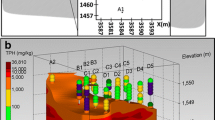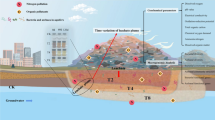Abstract
Microbial communities along vertical transects in the unsaturated zone were evaluated at five sites in the Pasco Basin, in southeastern Washington State. Sites with contrasting recharge rates were chosen to maximize or minimize the potential for microbial transport. Pore water ages along the vertical transects were established using natural chloride tracers, and ranged from modern to either ∼15,000 yBP (years before present) or ∼30,000 yBP at the two low-recharge sites. Unsaturated flow processes were short-circuited by preferential flow at two of the three high-recharge sites, resulting in rapid movement of water through the vertical transects. Microbial numbers and biomass, based on plate counts, and phospholipid fatty acid (PLFA) concentrations decreased with depth at all sites. The majority (55–90%) of the culturable chemoheterotrophs recovered from most samples were streptomycete bacteria. 16S rRNA gene sequence and MIDI analyses indicated that 75% of the remaining isolates were Gram-positive bacteria (most likely species of Arthrobacter and Bacillus) 25% were Gram-negative bacteria (probably members of several genera in the alpha- and gamma-Proteobacteria). Comparison of microbial communities at low-recharge sites vs. high-recharge sites, where preferential flow occurs, revealed several differences that might be attributed to vertical transport of microbial cells at the high-recharge sites. Plate counts and PLFA analyses indicated that the proportion of streptomycetes, which were abundant at the surface but present in the subsurface as spores, decreased, or remained constant, with depth at the low-recharge sites, but increased with depth at the high-recharge sites. PLFA analyses also indicated that Gram-negative bacteria displayed increased nutrient stress with depth at the high-recharge sites characterized by preferential flow, but not at the low recharge site. This may be a result of advective transport of microbes to depths where it was difficult for them to compete effectively with the established community. Moreover, PLFA community structure profiles fluctuated considerably with depth at the low-recharge sites, but not at the high-recharge sites. This might be expected if transport were distributing the microbial community along the vertical profile at the high-recharge sites. In contrast to the high-recharge sites at which preferential flow occurs, filtration likely prevented vertical transport of microorganisms at the high-recharge site that was characterized by unsaturated flow.
Similar content being viewed by others
Author information
Authors and Affiliations
Additional information
Received: 6 November 1996; Accepted: 9 May 1997
Rights and permissions
About this article
Cite this article
Balkwill, D., Murphy, E., Fair, D. et al. Microbial Communities in High and Low Recharge Environments: Implications for Microbial Transport in the Vadose Zone. Microb Ecol 35, 156–171 (1998). https://doi.org/10.1007/s002489900070
Issue Date:
DOI: https://doi.org/10.1007/s002489900070




